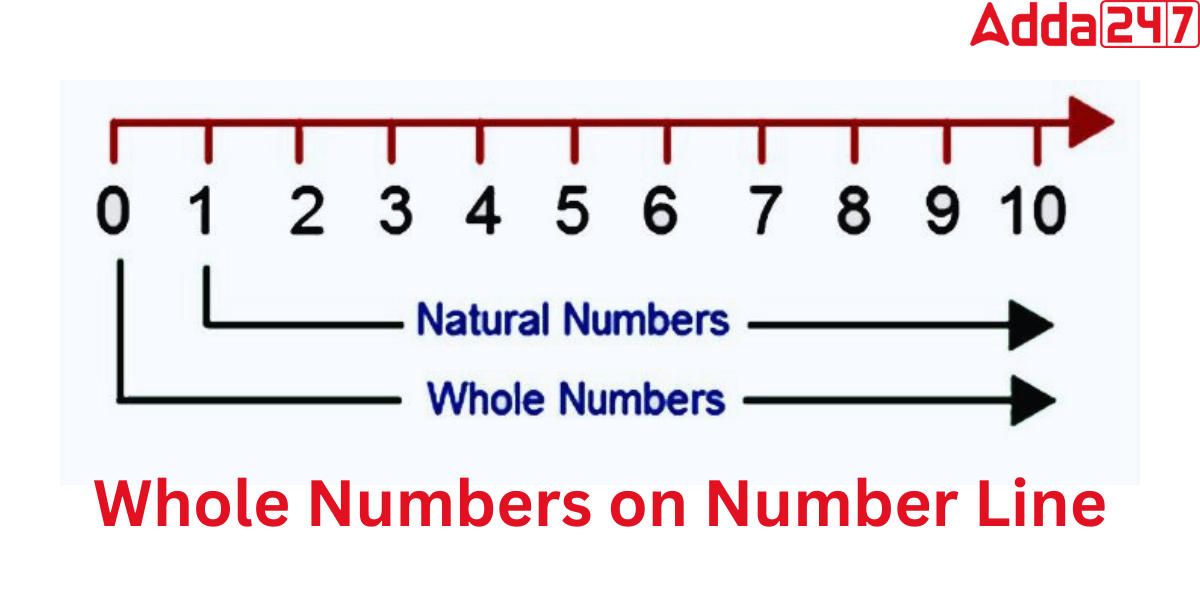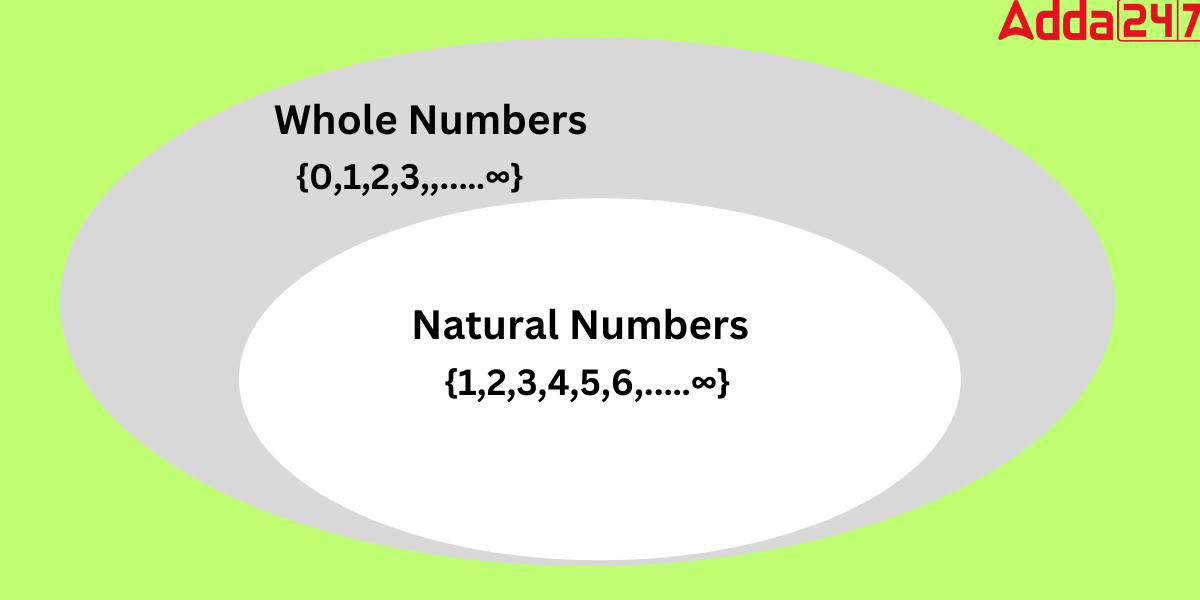Table of Contents
Whole Numbers: Whole numbers are a subset of the number system that comprises all positive integers ranging from 0 to infinity. The concept of Whole Numbers is very crucial to understand the Number system in maths. Basically, Whole Numbers are natural numbers including zero. As a result, the Whole Numbers starts from {0,1,2,3,4,5,6,7,….……∞}. The Whole numbers are also considered counting numbers. In this article, we are going to learn more about whole numbers, including Whole Numbers definition and examples.
Whole Numbers definition
Whole numbers are defined in mathematics as a set of natural numbers that includes 0. We know that natural numbers are a collection of counting numbers beginning with 1, 2, 3, 4, and so on. The set of Whole numbers includes natural numbers as well as zero (0). Alternatively, we can say that Whole numbers are a set of positive numbers and zeroes that do not contain any fractions, decimals, or even negative integers. Natural numbers are counting numbers in mathematics. As a result, the whole number is a collection of all natural numbers and 0. Whole numbers are all of the basic counting numbers in addition to zero (0).
Whole Numbers in Maths
Whole Numbers: Under mathematics, Whole Numbers have different importance of their own. It becomes easier to understand arithmetic, algebra, and number theory in the field of mathematics through integers because Whole Numbers are used the most in the fields.
Generally, the standard books written by CBSE and other educational boards provide information about Whole Numbers in very difficult language, which makes it difficult for the students to understand.
But in today’s article, we have provided you with all the information about Whole Numbers in the simplest language below. If you want to understand all the information about Whole Numbers in simple terms, then stay with us till the end of today’s article.
Whole Numbers Definition and Examples
We often have a little confusion between Natural Numbers and Whole numbers. natural is a set of all positive integers starting from one to infinity i.e. N= {1.,2,3,4, 5,6,7,8.,……, ∞} which numbers are often called counting Numbers. on the other hand, the whole number is a set of all-natural numbers with 0 (Zero0 that does not have a fractional or decimal component. Examples of whole numbers are all non-negative integers such as {0,1,2,3,4,5,6,7,….……∞}.
Whole Numbers List
Generally, Whole Numbers are a set of numbers that include all the natural numbers (positive integers) and zero. Whole Numbers do not include any negative numbers or fractions. They are represented by the set of numbers {0, 1, 2, 3, 4, 5, …}. Whole Numbers are used in many areas of mathematics, including arithmetic, algebra, and number theory. They are also used in everyday life situations, such as counting objects or measuring quantities. The list of whole numbers starts from zero and continues indefinitely, eliminating decimal numbers, fractions, and negative numbers. Earlier we know that whole Numbers can be defined as all the natural Numbers with 0. For better understanding, Let’s check the List of Whole Numbers 1 to 100 below.
Whole Numbers 1 to 100 |
| 0, 1, 2, 3, 4, 5, 6, 7, 8, 9, 10, 11, 12, 13, 14, 15, 16, 17, 18, 19, 20, 21, 22, 23, 24, 25,26, 27, 28, 29, 30, 31, 32, 33, 34, 35, 36, 37, 38, 39, 40, 41, 42, 43, 44, 45, 46, 47, 48, 49, 50, 51, 52, 53, 54, 55, 56, 57, 58, 59, 60, 61, 62, 63, 64, 65, 66, 67, 68, 69, 70, 71, 72, 73, 74, 75, 76, 77, 78, 79, 80, 81, 82, 83, 84, 85, 86, 87, 88, 89, 90, 91, 92, 93, 94, 95, 96, 97, 98, 99. |
Whole Numbers on Number line
The number line shown below makes it simple to see whole numbers on a number line. We learned that whole numbers are positive integers, including 0 from the definition of a whole number. The whole numbers are represented by all positive integers plus zero, while all positive integers on the right side of zero represent the natural numbers.

Whole Numbers symbol
wholes numbers is a part of the number system. In mathematics, the alphabet ‘W’ in uppercase is used to represent whole numbers. The set of whole numbers includes the Counting Numbers or Natural numbers such as {0, 1, 2, 3, 4, 5, 6, 7, 8, 9,……………} and Zero which represents a null value.
W = {0, 1, 2, 3, 4, 5, 6, 7, 8, 9, 10,11,12,13,14…}
Natural numbers and Whole Numbers
After learning the Whole Numbers definition and Examples we can now conclude that Every whole number except 0 is a natural number. Furthermore, we can also add that each natural number is a whole number. let’s understand with examples.
Let’s assume a Natural Numbers set is A ={ 1,2,3,,4,5,6,…….}
Now, assume a set of Whole numbers is {0,1, 2,3,,4,5,6,…….}
We can see that { 1,2,3,4,5,6,…….} is present in both sets of Natural numbers an whole Numbers. As a result, we can say that the set of natural numbers is a subset of the set of whole numbers.

Difference between Natural numbers and Whole Numbers
here we have tabulated certain differences between Natural numbers and Whole Numbers below.
| Whole Numbers | Natural Numbers |
| The whole number set is denoted as “W” | The natural number set is denoted as “N” |
| The Set of whole Numbers starts from 0 | The Set of Natural Numbers starts from 1. |
| The smallest whole number is 0. | The smallest whole number is 1. |
| .Except for 0, every whole number is a natural number. | Every Natural number is a whole number. |
| A whole number is not a subset of a natural number | A natural number is not a subset of the whole number |
Whole Numbers Facts
Check of some important key facts regarding whole Numbers.
- Whole numbers starts from 0 to infinity.
- The smallest whole numbers is 0 (Zero)
- There is no biggest whole number as the list of whole numbers is continued to infinity.
- All counting number is a whole numbers.
- Every positive integer, including zero, is a whole number.
- Real numbers are all whole numbers.
- All natural numbers are whole numbers, but not all whole numbers is a natural number.
- Every whole number is a rational number.
Properties of Whole Numbers
The properties of Whole Numbers include:
-
- Closure: Whole Numbers are closed under addition, subtraction, and multiplication. This means that if you add, subtract, or multiply any two Whole Numbers, the result is always a whole number.
- Commutative property: The order in which you add or multiply Whole Numbers does not affect the result. For example, 3 + 4 = 4 + 3 and 3 × 4 = 4 × 3.
- Associative property: The way you group the numbers when adding or multiplying does not affect the result. For example, (2 + 3) + 4 = 2 + (3 + 4) and (2 × 3) × 4 = 2 × (3 × 4).
- Identity property: The sum of any whole number and zero is that whole number itself. For example, 7 + 0 = 7.
- Distributive property: Multiplication distributes over addition. For example, 3 × (4 + 2) = (3 × 4) + (3 × 2).
- Divisibility: Whole Numbers can be divided by other Whole Numbers evenly. For example, 12 can be fully divided by 3, so 12 ÷ 3 = 4 with no remaining.
- Order: Whole Numbers can be ordered from least to greatest or greatest to least. For example, 2 < 5 and 7 > 4.
Whole Numbers Place value and positional notation
Place value and positional notation are important concepts in understanding how Whole Numbers are written and represented.
Place value Indicates the value of a digit-based position in a number. In Whole Numbers, the value of each digit is determined by its place in the number, starting from the rightmost digit. The first digit from the right represents ones, the second digit represents tens, the third digit represents hundreds, and so on. For example, in the number 347, the digit 7 represents 7 ones, the digit 4 represents 4 tens, and the digit 3 represents 3 hundred.
Positional notation, also known as the decimal system, is the way in which Whole Numbers are written using place value. This is a system where each digit can take on 10 different values (0-9), and the value of each digit is determined by its position in the number.
For example, the number 1234.56 is written using positional notation, where the digit 1 is in the thousands place, the digit 2 is in the hundreds place, the digit 3 is in the tens place, the digit 4 is in the ones place, the digit 5 is in the tenths place, and the digit 6 is in the hundredths place. The value of the number is the sum of the products of each digit and its corresponding place value. In this case, the value is 1 x 1000 + 2 x 100 + 3 x 10 + 4 x 1 + 5 x 0.1 + 6 x 0.01, which equals 1234.56.
Co Prime Numbers- Definition, Properties, List, and Examples
Operations on Whole Numbers
Operations on Whole Numbers include
- Addition
- Subtraction
- Multiplication
- Division
- Addition: Whole Numbers can be added together by aligning them according to place value and adding each column. The result is a sum that can be written as a whole number. For example, to add 42 and 73, you would align the one’s place and the tens place and add 2+3=5 in the one’s place and 4+7=11 in the tens place. So, the answer is 115.
- Subtraction: Whole Numbers can be subtracted by aligning them according to place value and subtracting each column. If the number in the column being subtracted from is smaller than the number being subtracted, then borrow from the next column to the left. For example, to subtract 36 from 79, you would start at the one’s place and subtract 6 from 9. Since 6 is smaller than 9, you need to borrow from the tens place. The 7 in the tens place becomes 6, and the 9 in the one’s place becomes 19. Then, you subtract 6 from 16 and get 10. So the answer is 43.
- Multiplication: Whole Numbers can be multiplied by using the distributive property and the multiplication table. The distributive property states that a x (b+c) = a x b + a x c. For example, to multiply 23 by 4, you can use the distributive property: 23 x 4 = 20 x 4 + 3 x 4 = 80 + 12 = 92.
- Division: Whole Numbers can be divided by long division or by using repeated subtraction. For example, to divide 75 by 5 using long division, you would divide 7 by 5 and get 1 with a remainder of 2. Then, you bring down the 5 and divide 25 by 5 and get 5. So, the answer is 15.
Composite Number- Definition, Example, 1 to 100 List
Real-life Examples of Whole Numbers
Problem: A farmer has 30 cows, and he wants to divide them equally into 6 different man. How many cows will be in each man?
Solution: To solve this problem, we need to divide the total number of cows (30) by the number of man (6):
30 ÷ 6 = 5
Therefore, there will be 5 cows in each man.
Problem: Sarah is planning to bake cookies and she needs to buy some ingredients. She needs 2 cups of sugar for each set of cookies, and she wants to make 8 sets. How many cups of sugar does she need in total?
Solution: To solve this problem, we need to multiply the amount of sugar needed for each batch (2 cups) by the number of batches (8):
2 x 8 = 16
Therefore, Sarah needs 16 cups of sugar in total.
Problem: A construction worker needs to lay bricks to build a wall that is 20 feet long. Each brick is 1 foot long. How many bricks does he need?
Solution: To solve this problem, we need to divide the length of the wall (20 feet) by the length of each brick (1 foot):
20 ÷ 1 = 20
Therefore, the construction worker needs 20 bricks.
Uses of Whole Numbers in Our Daily Life
Here are five applications of Whole Numbers:
- Counting: Whole Numbers are used for counting objects and quantities.
- Measurement: Whole Numbers are used to measure distances, weights, and volumes.
- Money: Whole Numbers are used in financial transactions, such as counting rupees and coins or calculating the tax.
- Time: Whole Numbers are used to measure time in hours, minutes, and seconds, and to perform calculations involving time.
- Sports: Whole Numbers are used in sports to keep score and record statistics.
Whole Numbers in Hindi
गणित में पूर्ण संख्याओं को प्राकृतिक संख्याओं के एक समूह के रूप में परिभाषित किया जाता है जिसमें 0 शामिल होता है। हम जानते हैं कि प्राकृतिक संख्याएँ 1, 2, 3, 4, इत्यादि से शुरू होने वाली गिनती संख्याओं का एक संग्रह है। पूर्ण संख्याओं के सेट में प्राकृतिक संख्याओं के साथ-साथ शून्य (0) भी शामिल है। वैकल्पिक रूप से, हम कह सकते हैं कि पूर्ण संख्याएँ धनात्मक संख्याओं और शून्यों का एक समूह होती हैं जिनमें कोई भिन्न, दशमलव या यहाँ तक कि ऋणात्मक पूर्णांक नहीं होते हैं। प्राकृतिक संख्याएँ गणित में संख्याओं की गिनती कर रही हैं। परिणामस्वरूप, पूर्ण संख्या सभी प्राकृत संख्याओं और 0 का एक संग्रह है। पूर्ण संख्याएँ शून्य (0) के अलावा सभी बुनियादी गणना संख्याएँ हैं।
हमें अक्सर प्राकृतिक संख्याओं और पूर्ण संख्याओं के बीच थोड़ा भ्रम होता है। प्राकृतिक एक से लेकर अनंत तक सभी सकारात्मक पूर्णांकों का एक सेट है यानी N= {1.,2,3,4, 5,6,7,8.,……, ∞} जिन्हें अक्सर गिनती कहा जाता है संख्याएँ। दूसरी ओर, पूर्ण संख्या 0 (शून्य0) के साथ सभी प्राकृतिक संख्याओं का एक सेट है जिसमें आंशिक या दशमलव घटक नहीं है। पूर्ण संख्याओं के उदाहरण सभी गैर-नकारात्मक पूर्णांक हैं जैसे कि {0,1,2,3 ,4,5,6,7,….……∞}.
| Related articles | |
| Prime Number List 1 to 100 | Integers: Numbers, Definition, Examples |
| Rational Numbers | Whole numbers-Definition and Examples |
| What are natural numbers? | Real numbers list |



 NEET Organic Chemistry Syllabus 2025, Ch...
NEET Organic Chemistry Syllabus 2025, Ch...
 NTA NEET Exam Date 2025 OUT, Exam Timing...
NTA NEET Exam Date 2025 OUT, Exam Timing...
 Class 10th result 2025 MP Board Announce...
Class 10th result 2025 MP Board Announce...










